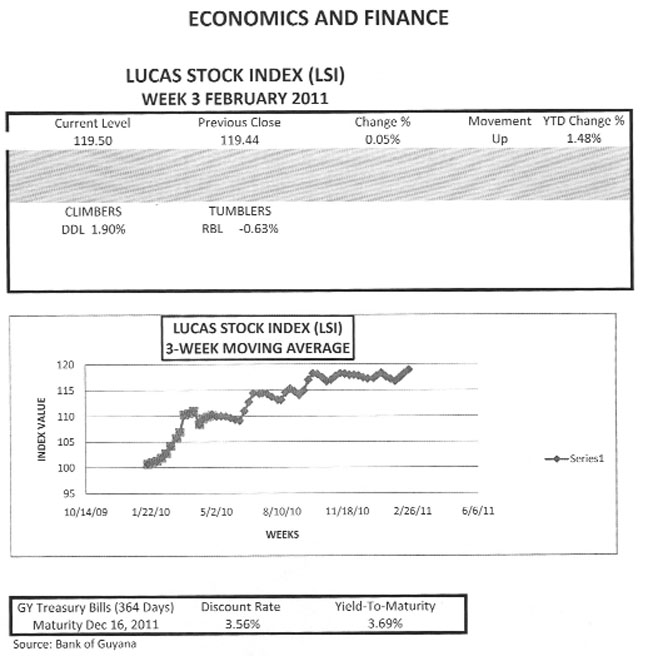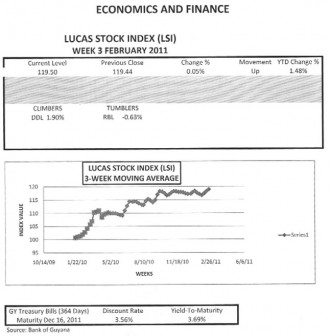(Part 1)
Services
At 63 percent, the service sector is responsible for the biggest share of income of the Guyana economy. Made up of 11 different groups of activities, the service sector embraces almost everything of social and economic importance: transportation, storage, communication, information, distribution, health, education, electricity, water, real estate services, financial services, public service, safety and security. Unlike the classification found in the 2002 Census report where construction was included among manufacturing activities, the national accounts measure it under services. With construction, the aggregation of activities in the service sector is responsible for 66 percent of the output generated by the Guyana economy in 2010.
Public Policy
As Guyanese continue to settle into the New Year and absorb the effects of the 2011 budget, they should realize that any adverse event of significance in the service sector could quickly alter their lives and those of the many families that have come to depend on it for their livelihood. The impact is often swift and immediate as with the removal of the street vendors from the Stabroek Market area and the strike of the minibus operators last month. The administration’s public policy on things like health, housing, technology, infrastructure, entertainment, and small business financing also resides and thrives amidst the various components of the service sector.
Thus, it is worth taking a look at what is going on in that part of the economy. The effort here and in its continuing pages looks at the relative importance of each component of the service sector within the sector itself and in the economy as a whole. It also highlights characteristics of industries and government policies that impact markets, consumer behaviour, choices and quality of life.
LUCAS STOCK INDEX
At the end of the third trading period of February 2011, the Lucas Stock Index (LSI) continued its sluggish growth. The index barely recorded a slight to push it to a year-to-date gain of 1.48 percent. The stocks traded this week were Banks DIH and Sterling Products Limited (SPL) which recorded no change, Demerara Distillers Limited (DDL), which recorded a 1.9 percent increase and Republic Bank Limited (RBL) which saw its stock price fall by six-tenths of one percent. Despite the positive movement in the stock prices this week, the value of the index continues to lag behind the yield on the risk-free Treasuries that will mature in December 2011.
Dominate
Peeping into the bowels of this sector with the help of the data published by the admirable employees of the Bureau of Statistics reveals that the distribution activities are the largest of the service sector. Commonly referred to as trading or commercial activities, the wholesale, retail, export and import businesses dominate the Guyana economy. They make available things that influence everyday life of Guyanese like the clothes they wear, the chairs that they sit on, the beds that they sleep on, the stoves that they cook on, the shoes that they put on among others that they buy and sell in the shops and on the streets that are important to making life easy and enjoyable.
Lucrative Income
Trading activities by themselves are the largest activity in the service sector and in the Guyana economy as a whole. The wholesale and retail trade makes up 14 percent of the output of the Guyana economy and 22 percent of the output of the service sector. It brings in 15 percent of the gross profits earned by businesses in Guyana and 24 percent within the service sector. Every dollar of output brings G$1.36 in revenues, placing it as the second most lucrative income earner of the service sector and among the top four in the country as a whole.
Hurt
What goes on in the area of the distributive trade clearly has direct consequences for consumers. Consumer choice, quality of goods and changes in prices are important. They can relieve or add to the frustration of consumers. In some cases, government policy could compound or alleviate the problem. The introduction of the value-added tax in 2007 at the high rate of 16 percent has hurt many consumers since the distributive trade is the place where the value-added tax (VAT) policy has the most direct impact. Similarly, the suspension or reduction of the (VAT) on some consumer items in 2008 helped many Guyanese cope with the economic crisis of that period. Guyanese might be at that point again where government intervention and its consequences need to be examined closely with the One Laptop per Family (OLPF) project providing a good example.
Sizable Share
Another activity with clout in the service sector is construction. It accounts for 10 percent of the economic activity of the country and 16 percent of the service sector. As would be expected, construction brings in a sizable share, 17 percent, of the income of the service sector. At its current level of activity, construction rivals gold as an important income earner in the Guyana economy. Largely owing to a nearly 27 percent increase in its price, gold accounts for 12 percent of income while construction accounts for 11 percent.
Lure
Surprisingly, price movement in construction is not as significant as expected. Indeed, it is hard to imagine that with the amount of construction activity taking place across Guyana and the shortage of highly skilled personnel, prices have moved less than five percent. The high volume of activity means the availability of jobs with its lure of instant income and the shortage of skilled workers ought to be pushing cost higher, but that seems to be happening slowly.
(To be continued)











